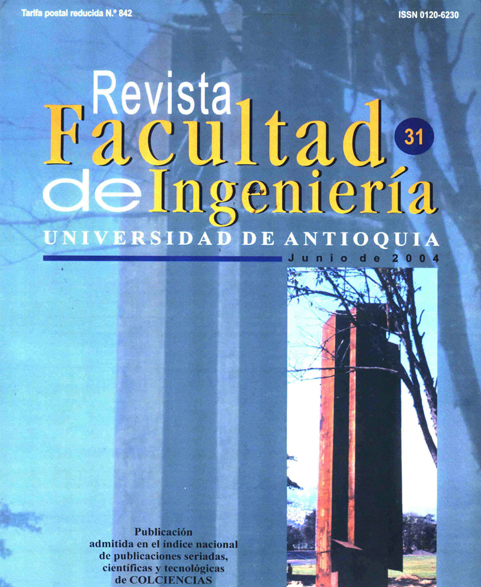Integrated removal of organic load, P, N, on a filters serial system, anaerobic, anoxic and aerobic on dynamic conditions
DOI:
https://doi.org/10.17533/udea.redin.344452Keywords:
Biofilter, nitrification, denitrification, phosphorus removal, carbon removal, nutrient removalAbstract
This paper shows the results obtained during the operation under dynamic conditions of a three biofilters serial system, anaerobic, anoxic and aerobic at lab scale to evaluate the N, P, and organic matter removal. The reactors were continuously fed for 200 days, including the adherence and stability periods, with hydraulic retention time among 2,27 and 0,66 d. for the ANABF and among 1,5 and 0,5 d. for the ANXBF. The adherence period was followed by a control of SSV and the DQO removal in each BF. After good results of adherence the system was fed with an initial average volumetric organic load of 0,441 kg DQO/m3/d. and gradually increase during the results of DQO removal over the 50%, until the achievement of the system stability for a maximum organic load of 1,5 kg. The reactor control was made by DQO, PO43-, NTK, NO2-, NO3-, SS and alkalinity, determined at the enter and exit of each reactor. The removal results for the system of growing adherence was among 90-96% for DQO, 80-90% for total P, and 65-70% for total N.
Downloads
References
Metcalf & Eddy, Inc. Ingeniería de aguas residuales. 3.a ed. Madrid. McGraw-Hill/Interamericana de España, S. A. U. 1995.1459 p.
Rittmann, Bruce y Mccarty, Perry. L. Biotecnología del medio ambiente; principios y aplicaciones. 1.a ed. Madrid. McGraw-Hill/Interamericana de España, S. A. U. 2001. 745 p.
Romero, Jairo A. Tratamiento de aguas residuales: Teoría y principios de diseño. Bogotá. Escuela Colombiana de Ingeniería. 2001. 1232 p.
Wild, D., et al. “Structured modelling of denitrification intermediates”. En: Water, Science and Technology. Great Britain. Vol. 31. No. 2. 1995. pp. 45-54. DOI: https://doi.org/10.2166/wst.1995.0070
Van Loosdrecht, M. C. M. And Jetten, M. S. M. “Microbiological conversions in nitrogen removal”. En: Water Science and Technology. Vol. 38. No. 1. 1998. pp. 1-7. DOI: https://doi.org/10.2166/wst.1998.0002
Tankovic, Zlatko. “Energetics of enhanced biological phosphorus and nitrogen removal processes”. En: Water Science and Technology. Vol. 38. No. 1. 1998. pp. 177- 184. DOI: https://doi.org/10.2166/wst.1998.0043
Alonso, V. et al. “Eliminación biológica del fósforo en condiciones anóxicas”. En: Ingeniería química. España. Junio, 1998. pp. 109-114.
Kern, Jespersen. J. P. and Hanze, M. “Biological phosphorous uptake under anoxic and aerobic conditions”. En: Water Research Vol. 27. No. 4. 1993. pp. 617- 624. DOI: https://doi.org/10.1016/0043-1354(93)90171-D
Kuba , T. et al. “Biological phosphorous removal from wastewater by anaerobic-anoxic sequencing batch reactors”. En: Water, Science and Technology. Great Britain. Vol. 27. No. 5-6. 1993. pp. 241-252. DOI: https://doi.org/10.2166/wst.1993.0504
Bortone, G. et al. “Biological anoxic phosphorous removal: the Dephanox process”. En: Water, Science and Technology. Great Britain. Vol. 34. No. 1-2. 1996. pp. 119-128. DOI: https://doi.org/10.2166/wst.1996.0363
Sheker, R. E. et al. “The effects of fill strategies on SBR performance under nitrogen deficiency and rich condition”. En: Water Science and Technology. Vol. 28. No. 10. 2001. pp. 259-266. DOI: https://doi.org/10.2166/wst.1993.0242
Water Environ Federation and American Society of Civil Engineers. Design of Municipal Wastewater Treatment Plants. Vol. II. 2.a ed. USA. 1991. pp. 943 - 944.
Downloads
Published
How to Cite
Issue
Section
License
Revista Facultad de Ingeniería, Universidad de Antioquia is licensed under the Creative Commons Attribution BY-NC-SA 4.0 license. https://creativecommons.org/licenses/by-nc-sa/4.0/deed.en
You are free to:
Share — copy and redistribute the material in any medium or format
Adapt — remix, transform, and build upon the material
Under the following terms:
Attribution — You must give appropriate credit, provide a link to the license, and indicate if changes were made. You may do so in any reasonable manner, but not in any way that suggests the licensor endorses you or your use.
NonCommercial — You may not use the material for commercial purposes.
ShareAlike — If you remix, transform, or build upon the material, you must distribute your contributions under the same license as the original.
The material published in the journal can be distributed, copied and exhibited by third parties if the respective credits are given to the journal. No commercial benefit can be obtained and derivative works must be under the same license terms as the original work.










 Twitter
Twitter